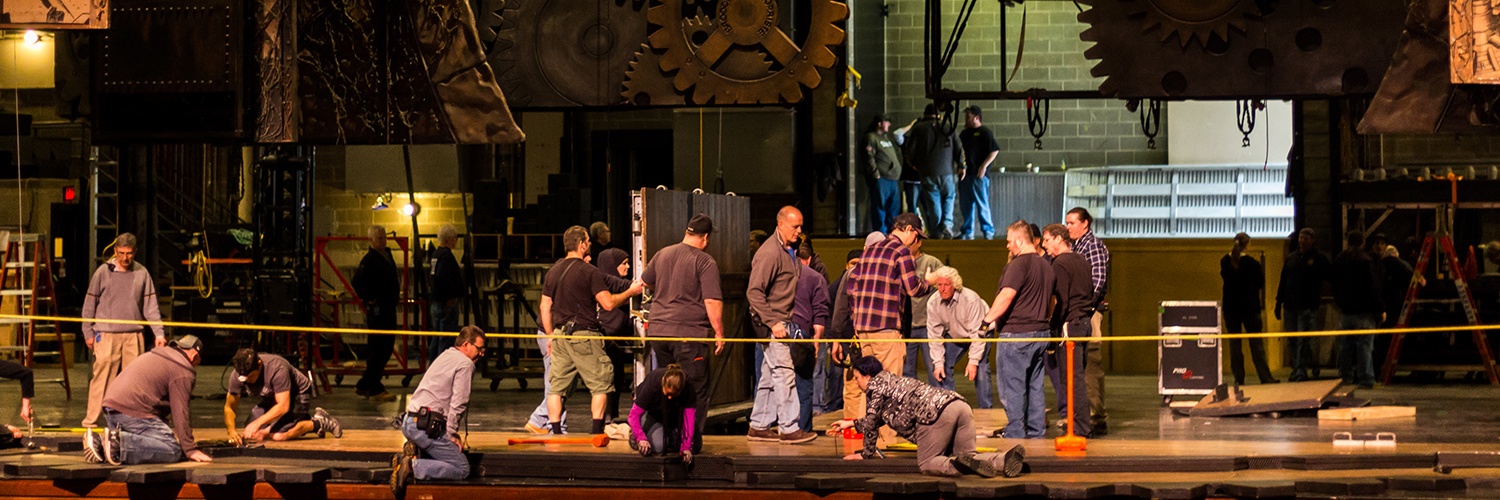Last week marked the fifth time the Benedum Center’s curtains have opened to the spectacle of Wicked, the wildly-popular untold story of the Witches of Oz. The touring production is settling in for a three-week-long stay here in Pittsburgh, playing 24 performances to a packed house each night.
Just over a week ago, however, there was no trace of witches, dragons, or munchkins to be found on stage in Pittsburgh. In fact, last Sunday the show wrapped for the final time in Chicago, a few hundred miles away from Wednesday’s opening performance in the Benedum. That’s a slim window to deconstruct, transport, and reconstruct a complicated, multi-million dollar Broadway production. So how do they pull it off, anyway?
David O’Brian, the show’s Production Stage Manager, and Steve Quinn, the show’s Company Manager, shed some light on the frantic process in a recent informational lunch held for Pittsburgh Cultural Trust members. With the set quite literally being pieced together behind them as the two spoke, they explained that the entire process in Pittsburgh began on the Monday directly following the final Chicago show.
Stagehands spent about 10 hours unloading two advance semi trucks full of the elaborate set’s initial pieces. That largely included the “air show” as they called it, which consists of lighting, curtains, and some of the flying scenery pieces.

Monday was only the tip of the iceberg, though, as Tuesday brought eleven more 52-foot-long semi trucks to the crowded streets of Downtown. Over the course of the 14-hour day, around 100 stagehands — 18 from the tour and the rest from Pittsburgh — scrambled to piece together the majority of the set.
That includes what they called the “deck show,” or the floor built on top of the Benedum’s stage. One of the large challenges with a travelling production is consistency. Having each set piece land in the same place each performance, in any theater, can be tricky. The solution is the deck, which incorporates tracks to guide stage elements to the exact same spot — every single night.
As for the Benedum Center itself, O’Brian and Quinn say it’s a nicer theater to work in than many due to its size. While the stage is always the same (again, thank the deck for that), the backstage area varies based on the theater. The Benedum is one of the larger houses the tour works with, meaning everybody has just a little bit more personal space. For the 70+ people on non-stop tour with the show, that’s a big plus.
On Wednesday the final pieces of the puzzle — items like props, smaller set pieces, and $2 million worth of costumes — come together like clockwork. Quite fitting, really, as legendary designer Eugene Lee intended for the set to resemble the inner workings of a grandfather clock. The stagehands finished up their work in time for the cast to arrive and begin prep for the 7:30pm opening show.

In total, Wicked takes about two-and-a-half days — 30 hours in all — to load into a new city. O’Brian and Quinn note that the sheer size and complexity of Wicked’s set requires a longer construction time; most travelling Broadway shows do it in two, with a Tuesday opening. They point to Wicked’s faithfulness to its Broadway counterpart as the main reason for the added time. The only real difference between the two shows is that the touring production can’t build their set out into the theater itself.
All that said, after 30 hours of frantic work the Benedum’s stage was transformed into the Oz-ian wonderland now pleasing audiences night after night. As much as fans would love it, however, the show isn’t here in Pittsburgh to stay. No, on February 11 the curtain will fall for the last time here in the Steel City and the stagehands will have five hours to tear the entire thing down once more. The tour can take the smallest of breaths for a week and a half as the thirteen trucks turn their wheels towards Ft. Lauderdale, Florida.
Soon enough, though, it’s time to do it all again.
